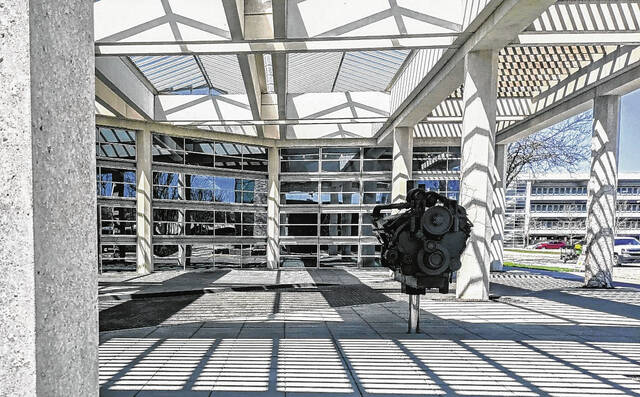
Mike Wolanin | The Republic Cummins employees walk to the newly remodeled workspace in the Cummins Corporate Office building in Columbus, Ind., pictured Tuesday, July 23, 2019.
Republic file photo Cummins Inc. Corporate Office Building in downtown Columbus is shown in this file photo from 2021.
Cummins Inc. will supply a Florida utility company with an electrolyzer system as part of a pilot project involving a first-of-its-kind green hydrogen plant in the state, the company announced Monday.
The system, which will include five Cummins electrolyzers, will be used in Florida Power & Light Company’s Cavendish NextGen Hydrogen Hub, which Cummins described as “the first of its kind ‘green’ hydrogen plant” in the state. The electrolyzer system will have a capacity of 25 megawatts — enough to produce 10.8 tons of green hydrogen per day.
Electrolyzers are devices that use electricity to split water molecules into hydrogen and oxygen, a process called electrolysis, according to the U.S. Department of Energy. The resulting hydrogen is emissions-free, or “green,” if the electricity used by the electrolyzer comes from renewable sources such as solar or wind.
In this case, the hub will use solar energy to power the electrolysis process, Cummins said. The hydrogen that the system produces will be blended with natural gas and used to power an existing combustion turbine at a clean energy center located about 70 miles southeast of downtown Orlando.
Cummins is headquartered in Columbus and employs about 8,000 people in the Bartholomew County area.
“This project is exciting for Cummins as we establish green hydrogen as a viable way to decarbonize the economy here in the United States,” said Amy Davis, Cummins vice president and president of new power, in a statement.
The announcement comes as companies around the world — including Cummins — are increasingly exploring green hydrogen to reduce emissions from power plants, semi-trucks, buses and trains, among other applications.
Cummins, for its part, expects green hydrogen to play an important role in cutting emissions in some of the industries that are most dependent on fossil fuels. The company said on Monday that it now has 600 electrolyzers around the world.
In 2020, company officials unveiled plans for how it intends to ramp up its hydrogen production and fuel cell business in the coming years amid a global push to curb greenhouse gas emissions and avert the threat of catastrophic climate change.
One of the technologies that Cummins officials touted during a virtual conference that year included electrolyzers. At the time, company officials said its electrolyzer installations were located on five continents, including the first fueling stations in Scotland, Sweden, Norway and Southeast Asia.
During the event, Cummins projected that its electrolyzer business will have about $400 million in annual revenues by 2025.
Green hydrogen is produced by using renewable electricity to separate hydrogen atoms from oxygen atoms in water molecules, according to the U.S. Department of Energy’s Office of Energy Efficiency and Renewable Energy. The hydrogen can be used, among other things, to power a wide range of applications, including vehicles outfitted with fuel cells.
However, most hydrogen today is not green, but rather extracted from natural gas in a process that generates that carbon dioxide emissions.
But the Florida installation “solidifies” the technology “as a key to reaching zero emissions in energy-intensive industries,” Davis said in a statement. Florida Power & Light Company said that the pilot project “is expected to guide the way for future use of hydrogen in a larger way,” according to a 10-year site plan it filed last year with state regulators.
“(Florida Power & Light’s) commitment to the acceleration of the energy transition and support of future demand for affordable renewables is one we passionately share,” Davis said.




